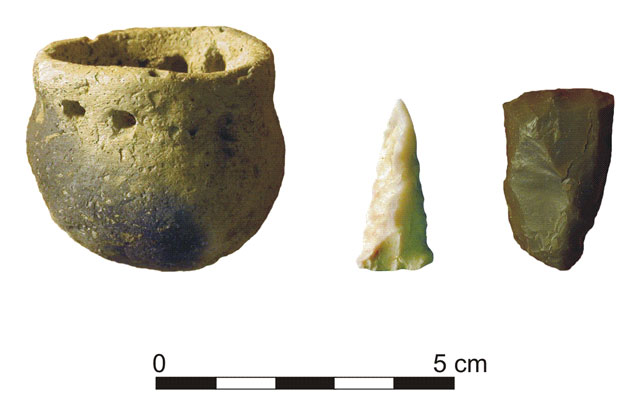Bone Bank Archaeological Research
Posey County, Indiana
Rescue Excavations at the Bone Bank Archaeological Site in Southwestern Indiana
 Introduction
Introduction
 Indiana's First Archaeological Excavation
Indiana's First Archaeological Excavation
 Survey and Testing
Survey and Testing
 Significance
Significance
 Project Goals
Project Goals
 Research Stages
Research Stages
 Expected Results
Expected Results
 Bone Bank in 2000
Bone Bank in 2000
 Planning for 2001
Planning for 2001
 Current Work
Current Work
 In the News
In the News
 Fall 2001 Lecture
Fall 2001 Lecture
 References
References
 Geomorphological History
Geomorphological History
 Links
Links
 Maps
Maps

EXPECTED RESULTS
The primary result of the rescue excavation will be the recovered and curated collection of materials and the report of findings. However, the public’s interest in this project is large, and to meet this interest we have planned additional elements of the project.
Examples of some of the exhibit quality artifacts recovered from excavations in the North Block, Fall 2000. Left: miniature pottery jar, with opposed pairs of holes at the neck, for suspension. Center: complete trianular arrow point, Madison type; this point appears to be undamaged; perhaps it was lost rather than discarded. Right: complete endscraper of Wyandotte chert, scraping end at the top, haft end inserted into handle at the bottom; endscrapers are primarily hide-working tools; the sides and end have been resharpened, and this reworking has made the left side narrower than the hafted portion of the tool.

First, copies of the project report will be filed at regional historical organizations and public libraries. Second, publication of a summary version of this report will be proposed to the DNR-Division of Historic Preservation and Archaeology, whose emerging publication list would benefit from publishing such a report.
For immediate communication with the public, the project will establish and update a web site to report and illustrate the work being undertaken and to announce initial results. The web site will be especially valuable to teachers and pre-college level students, because Bone Bank is not a site that is suitable for public visits (poison ivy is rampant, and there is a steep river bank).
In addition, several organizations in southwestern Indiana (Harmonie Associates, Friends of Angel Mounds, the Workingmen’s Institute of New Harmony, are planning to sponsor public lectures about the work at Bone Bank. (Harmonie Associates scheduled a public lecture in New Harmony for November 10, 2000, and the Friends of Angel Mounds and the University of Southern Indiana are sponsoring a lecture on September 21, 2001).
While the reports, web site information, and lectures all have an educational element, the rescue excavations at the Bone Bank site will be highlighted during future Indiana Archaeology Week programs in southwestern Indiana, in exhibits and pamphlets.
Return to Top
Last updated on 8/06/2001
Send Comments to: munsonc@indiana.edu
Site sponsored by Indiana University
 Introduction
Introduction
 Indiana's First Archaeological Excavation
Indiana's First Archaeological Excavation
 Survey and Testing
Survey and Testing
 Significance
Significance
 Project Goals
Project Goals
 Research Stages
Research Stages
 Expected Results
Expected Results
 Bone Bank in 2000
Bone Bank in 2000
 Planning for 2001
Planning for 2001
 Current Work
Current Work
 In the News
In the News
 Fall 2001 Lecture
Fall 2001 Lecture
 References
References
 Geomorphological History
Geomorphological History
 Links
Links
 Maps
Maps

